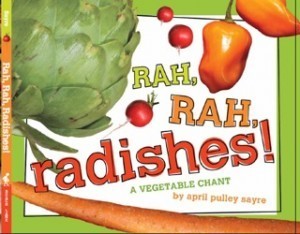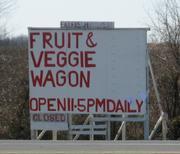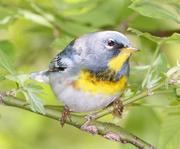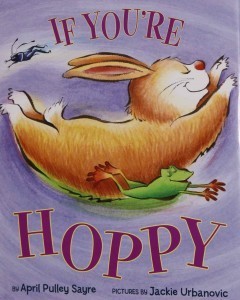April Pulley Sayre's Blog, page 13
May 28, 2011
What a BBC Show Inspired Me To Do
In 2006 I watched British chef Jamie Oliver's 4-part BBC documentary, "Jamie's School Dinners," in which he interviewed children and found that many didn't know the names of vegetables. As a girl who grew up picking vegetables on her grandparent's farm, that shocked me. I had to do something.
I'd already been worrying about childhood obesity because of my work as a visiting author in schools; I see about 17,000 school kids each year. I've noticed that some audiences are sluggish, having a tough time brainstorming, asking questions, and responding quickly and creatively. It just seems like they're not feeling good. These audiences also seem to have the highest numbers of kids struggling with obesity, and the worst time to speak with them is soon after a greasy school lunch.
After watching the BBC show, I wondered, how could these kids change their eating habits? How could they find, choose, or prepare healthy foods such as vegetables if the entire vegetable aisle was a foreign country to them?
I knew from my work, and from my previous chant books, that kids can easily learn new words if they are in a chant form. Then, when kids are out in the world and they see a chant word, they connect with it. Perhaps I could do something in this small way.
Rah, Radishes: A Vegetable Chant (Beach Lane Book/S&S, release June 14, 2011) is about having fun with vegetables—and with delicious words, colors, and shapes. I photographed the book at our local South Bend Farmer's Market over the course of four years. The farmers are so excited about the book. (They know which carrot or celery is theirs!)
Once kids read the book, I hope they'll have vegetable names, colors, and shapes in their heads. Perhaps they'll stop and actually point at a potato, laugh at a rutabaga, try broccoli for the first time.
Of course, this book is just a tiny piece of what needs to be done to help kids have healthier lives. So many people are putting their hearts and hands into the work of providing kids with better food choices. My hope is that folks doing this important work will find the book—and any joy and conversation it sparks—helpful in their efforts.
May 23, 2011
Vulture View review and activities
Author/educator Shirley Duke's Simply Science blog has a lovely review of Vulture View and some follow up activities. Hooray! Check the link here.
May 18, 2011
Calling All Collard Greens
Just about the only time we ate collard greens, specifically, was on New Years Day. Then, it was a good luck food, along with black-eyed peas. I grew up in South Carolina and this is a southern U.S. tradition. It also shows up in other countries and cultures, too. Collard greens are a healthy, everyday, part of soul food meals beloved in the South.
In our family, though, mostly, we just ate "greens." No kind specified. Often, we kids would turn up our noses. Mom would make us eat a few bites. The greens were stewed with ham or bacon. They were gloppy and often topped with vinegar. Sorry, Mom, but that's still not my favorite preparation.
Now I eat greens a lot. I love them on pizza. I add them to soups or quickly wilt them through stir frying. Usually, I choose softer-leaved greens such as Swiss chard. (Okay, so I'm a Swiss chard fan. The plant is gorgeous in the garden.)
Collard greens, though, have their own charms. It turns out, they're actually brassicas. Think of collard greens as a very loose-leafed relative of cabbage. The leaves are full of terrific nutrition. Like most vegetables, they contain compounds whose effects scientists are still trying to study. Just go with the simple info: Mom says greens are good for you. Do you really need all the details?
When it comes to lettuces and greens, usually the greener the better if you're looking for nutrition. Collard greens are mild in flavor, not peppery like turnip greens. Collard greens are fibrous and the long cooking helps make them easier to eat, particularly if the leaves are older and large.
I'm fresh out of collard greens photos. Waiting for them to come into season locally. So, you can look at a google image page, first: Google Image Search of Collard Greens http://bit.ly/iIq98Q
There are lots of good resources for further collard green studies. Here are a few links.
Greeks and Romans Grew Collards
http://aggie-horticulture.tamu.edu/archives/parsons/PUBLICATIONS/VEGETABLETRAVELERS/kale.html
Growing and Harvesting Collards
http://urbanext.illinois.edu/veggies/collards.cfm
Cooking Collard Greens
http://www.foodnetwork.com/recipes/paula-deen/collard-greens-recipe/index.html
May 15, 2011
Garden Storytime
This handout of garden activities, created by librarian Heather Acerro of Ft. Wayne, goes well with Rah, Rah, Radishes: A Vegetable Chant. It is used with her permission. Click to access this pdf. Sayre ALA 2011 BookTalk Handout2
Performing Rah, Rah, Radishes: a Vegetable Chant
Act It Out!
Divide students (or teachers) into pairs or small groups. Have each group write out and learn a stanza (four lines). They can decide how to perform it. Here are some aspects of the chant that performers have tried in the past:
saying the entire chant in unison
saying only part in unison
alternating speakers for each word
popping up then sitting down for each speaking turn
adding claps, snaps, and arm shapes
making poster art for each vegetable
bringing real vegetables to show when each is mentioned
Audio samples to help in teaching and reading Rah, Rah, Radishes: a Vegetable Chant and April Pulley Sayre's other chant books (Trout, Trout, Trout: A Fish Chant; Ant, Ant, Ant: An Insect Chant; and Bird, bird, Bird: a Chirping Chant) are available on the front page of www.aprilsayre.com or athttp://www.aprilsayre.com/2011/04/07/the-chant-books-read-taste-teach/
Rah, Rah, Radishes: A Fruit Chant Extensions
Here are some concepts to explore during small group and one-on-one readings of Rah, Rah, Radishes: A Vegetable Chant:
Colors and shapes. Engage young readers in discussing what they observe about vegetable colors and frame colors. Study other qualities such as bright, dark, and shiny.
Patterns. Quantities. Are the vegetables dumped straight onto a table? Are they organized in any way? How? Why do you think they are in boxes, piles, and small groups? Who do you think organizes them and why?
Different and the same. Which vegetables are the same? Which are different? Which show up in several parts of the book? Be a vegetable detective!
Vegetable identities. Are there any vegetables your students cannot identify? Research to find other photos of them and compare to the chant photos. (See other books and websites such as the author's for additional photos.) Even better, bring in the real veggies for hands on study, cross section, drawing, and tasting. Encourage students to use all their senses!
Vegetable math. Encourage readers to count the vegetables. Advanced students might calculate or discuss how much it might cost to buy three baskets, four boxes, and other amounts of vegetables in photos that have prices.
Vegetable art. One of the best ways to know something is to draw it. Why not bring in some live vegetables for children to draw so they can study vegetable colors and shapes?
For garden, harvest, and vegetable book pairings and activities, see the
"In My Garden" handout prepared by children's librarian Heather Acerro of Allen County, IN.
Rah, Rah, Radishes Booktalk and Shelf Talker
Rah, Rah, Radishes!: A Vegetable Chant by April Pulley Sayre. New York: Beach Lane Books/S&S, 2011.
Shelf talker (written teaser): What vegetable rhymes with "oh boy"?
BOOKTALK
Keep the front cover of the book hidden. Show the back cover of the book. Ask the audience: "What do you think this book is about?" (Listen/discuss audience suggestions.)
"Hmm…good ideas! Let's taste a few words and see if you're right."
"Repeat after me. Rah, rah, radishes!" (Audience: Rah, rah, radishes.)
"Red and white." (Audience: Red and white!)
"Carrots are calling." (Audience: Carrots are calling.)
"Take a bite!" (Audience: Take a bite!)
"This book is about . . ." (Turn over and show cover) "Vegetables! It's also about exploring a farmer's market and tasting rhythm and rhyme."
May 8, 2011
Fruit and Veggie Links

Just beginning to research veggie links that might be useful for classrooms/educators. Here are a few. Feel free to suggest more
Growing Chefs
Food Education from Field to Farm
Founded by Annie Novak, co-founder of Eagle Street Rooftop Farm. Offers gardening, workshops, consulting, education. Based in NYC.
http://growingchefs.org/
Children plant vegetables at the White House
The following site has quite a lot of downloadable veggie activities. It is produced by Produce for Better Health Foundation, an industry organization that is supported by large companies in the produce and food business. It also has information on healthier vending machine options, such as fruit.
http://www.pbhfoundation.org/educators/teachers/activities/packweek/PACK_materials.php
General Articles
"Getting Your Kids to Eat Healthy Foods" by Linda Larson
http://busycooks.about.com/od/healthyrecipes/a/kidsnutrition.htm
Cool layouts for vegetable gardens
http://www.squidoo.com/VegetableGardenLayout
Articles about research:
Eating vegetables, fruits as children linked to healthier arteries as adults.
http://www.newsroom.heart.org/index.php?s=43&item=1208
Increasing children's acceptance of vegetables; a randomized trial of parent-led exposure.
http://www.ncbi.nlm.nih.gov/pubmed/12781165
Children's Vegetable Intake LInked to Popeye Cartoons.
http://www.sciencedaily.com/releases/2010/08/100806080218.htm
Children ate twice as many veggies if they were given a funny name.
* Okay, personally, I think you don't need to change the name, just have fun with real names, a la Rah, Rah, Radishes. But that's just my nonfiction take on things…
http://www.msnbc.msn.com/id/29468137/ns/health-diet_and_nutrition/t/making-veggies-cool-kids/
May Animal: Warbler

In the month of May, Jeff and I take a special vacation just to watch warblers that migrate through the Midwest at this time of year. This is a Northern Parula at Magee Marsh in Ohio.
April 22, 2011
If You're Hoppy!
 If You're Hoppy came out in Feb and has been hopping into libraries, book stores, arms. SLJ said "Sure to be a storytime staple, with many repeat performances." For storytime fun, check out my article and photos of hopping animals, plus links to hopping animal video and a craft on the Under the Green Willow blog.
If You're Hoppy came out in Feb and has been hopping into libraries, book stores, arms. SLJ said "Sure to be a storytime staple, with many repeat performances." For storytime fun, check out my article and photos of hopping animals, plus links to hopping animal video and a craft on the Under the Green Willow blog.
April Pulley Sayre's Blog
- April Pulley Sayre's profile
- 105 followers



